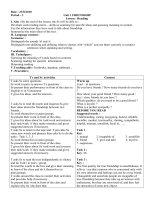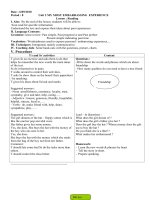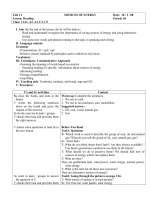giáo án tiếng anh lớp 11 unit 16 english 12
Bạn đang xem bản rút gọn của tài liệu. Xem và tải ngay bản đầy đủ của tài liệu tại đây (484.61 KB, 13 trang )
Period 95
Designed and presented by
Đinh Thị Thủy
THPT Đông Sơn I
/ə,sousi'eiʃn/ hiệp hội
/ə'ridʤənl/căn nguyên,
đầu tiên
/əd'mit/ kết nạp
/goul/mục tiêu
/æk'seləreit/ làm
nhanh thêm
/progress/sự tiến bộ
/prə'mout/ thúcđẩy
/stə'biliti/sự ổn định
/ris'pekt/ sự tôn trọng
/'dʤʌstis/ sự công bằng
The Association of Southeast Asian
Nations, or ASEAN, was founded on 8th
August, 1967, in Bangkok, Thailand by the
five original member countries, namely,
Indonesia, Malaysia, the Philippines,
Singapore and Thailand. Brunei joined
ASEAN in 1984. Vietnam became its
seventh member in 1995. Laos and
Myanmar were admitted to this association
in 1997, and Cambodia in 1999. The main
goals of the Association are to accelerate
economic growth, social progress and
cultural development; and to promote
peace and stability through respect for
justice, and the rule of law, in the
relationship between countries in the
region.
/stə'tistiks/ thống kê
GDP: tổng sản phẩm
quốc nội
tỷ lệ trung bình
/'meidʤə/chủ yếu
khu vực mậu dịch tự do
/is'tæbliʃ/ thành lập
/ə'dɔpt/chấp nhận và
thực hiện
/fɔ:dʤ/ tiến lên
/'viʤn/ tầm nhìn
/,inti'greiʃn/ sự hợp nhất
/,riəlai'zeiʃn/ sự hiện thực hóa
ASEAN has a population of 575.5 million,
accounting for about 8.7% of the world’s population.
Its total area is 4,464,322 square kilometres. It is a
region of diverse cultures, and people in some
countries such as the Philippines, Brunei, Malaysia
and Singapore speak English besides their own
languages. According to the statistics recorded in
2007, ASEAN had a combined gross domestic
product of about US$ 1282billion. This combined
GDP grew at an average rate of around 6% per year
from 2003 to 2007. The economies of the member
countries are diverse, although its major products
include electronic goods, oil and wood. The
Governments of ASEAN countries have paid special
attention to trade. In 2006, the ASEAN region had a
total trade of US$ 1405 billion. It has been estimated
that a free trade area would be established in the
region by 2020. The ASEAN leaders have also
adopted the ASEAN Vision 2020, which is aimed at
forging closer economic integration within the region.
The Hanoi Plan of Action, adopted in 1998, serves as
the first in a series of planned actions leading up to
the realization of the ASEAN Vision.
/kou,ɔpə'reiʃn/
sự hợp tác
/in'vestmənt/ đầu tư
phát triển nông thôn
/,trænspɔ:'teiʃn/
/'fɔristri/ lâm nghiệp
doanh nghiệp vừa và nhỏ
tình hình kinh tế - xã hội
Today, ASEAN economic
cooperation covers many areas:
trade, investment, industry, services,
finance, agriculture, rural
development, forestry, energy,
transportation and communication,
science and technology, small and
medium enterprises, and tourism.
ASEAN has actively worked to
improve the socio-economic
situation and solve problems among
its member countries.
justice
1. They are demanding equal rights and _____________.
2. _____________
is the total value of goods and services produced by
GDP
a country in one year.
diverse
3. Her interests are very ______________.
4. He talked about the _______________
integration of black children into the
school system in the southern states of America.
accelerate the rate of
5. At present, Vietnam is trying its best to ________
economic growth.
6. The road is bordered by shopping centres, restaurants and other
enterprises
commercial ______________
1
2
3
4
5
6
√
The AssoĠciation of Southeast Asian Nations, or
ASEAN, was founded on 8th August, 1967, in Bangkok,
Thailand by the five original member countries, namely,
Indonesia, Malaysia, the Philippines, Singapore and
Thailand. Brunei joined ASEAN in 1984. Vietnam
became its seventh member in 1995. Laos and Myanmar
were admitted to this association in 1997, and Cambodia
in 1999. The main goals of the Association are to
accelerate economic growth, social progress and cultural
development; and to promote peace and stability through
respect for justice, and the rule of law, in the
relationship between countries in the region.
×
ASEAN has a population of 575.5 million, accounting for about 8.7% of
the world’s population. Its total area is 4,464,322 square kilometres. It is
a region of diverse cultures, and people in some countries such as the
Philippines, Brunei, Malaysia and Singapore speak English besides their
own languages. According to the statistics recorded in 2007, ASEAN had
a combined gross domestic product of about US$ 1282billion. This
combined GDP grew at an average rate of around 6% per year from 2003
to 2007. The economies of the member countries are diverse, although its
major products include electronic goods, oil and wood. The Governments
of ASEAN countries have paid special attention to trade. In 2006, the
ASEAN region had a total trade of US$ 1405 billion. It has been
estimated that a free trade area would be established in the region by
2020. The ASEAN leaders have also adopted the ASEAN Vision 2020,
which is aimed at forging closer economic integration within the region.
The Hanoi Plan of Action, adopted in 1998, serves as the first in a series
of planned actions leading up to the realization of the ASEAN Vision.
×
ASEAN has a population of 575.5 million, accounting for about 8.7% of
the world’s population. Its total area is 4,464,322 square kilometres. It is
a region of diverse cultures, and people in some countries such as the
Philippines, Brunei, Malaysia and Singapore speak English besides their
own languages. According to the statistics recorded in 2007, ASEAN had
a combined gross domestic product of about US$ 1282billion. This
combined GDP grew at an average rate of around 6% per year from 2003
to 2007. The economies of the member countries are diverse, although its
major products include electronic goods, oil and wood. The Governments
of ASEAN countries have paid special attention to trade. In 2006, the
ASEAN region had a total trade of US$ 1405 billion. It has been
estimated that a free trade area would be established in the region by
2020. The ASEAN leaders have also adopted the ASEAN Vision 2020,
which is aimed at forging closer economic integration within the region.
The Hanoi Plan of Action, adopted in 1998, serves as the first in a series
of planned actions leading up to the realization of the ASEAN Vision.
√
ASEAN has a population of 575.5 million, accounting for about 8.7% of
the world’s population. Its total area is 4,464,322 square kilometres. It is
a region of diverse cultures, and people in some countries such as the
Philippines, Brunei, Malaysia and Singapore speak English besides their
own languages. According to the statistics recorded in 2007, ASEAN had
a combined gross domestic product of about US$ 1282billion. This
combined GDP grew at an average rate of around 6% per year from 2003
to 2007. The economies of the member countries are diverse, although its
major products include electronic goods, oil and wood. The Governments
of ASEAN countries have paid special attention to trade. In 2006, the
ASEAN region had a total trade of US$ 1405 billion. It has been
estimated that a free trade area would be established in the region by
2020. The ASEAN leaders have also adopted the ASEAN Vision 2020,
which is aimed at forging closer economic integration within the region.
The Hanoi Plan of Action, adopted in 1998, serves as the first in a series
of planned actions leading up to the realization of the ASEAN Vision.
×
ASEAN has a population of 575.5 million, accounting for about 8.7% of
the world’s population. Its total area is 4,464,322 square kilometres. It is
a region of diverse cultures, and people in some countries such as the
Philippines, Brunei, Malaysia and Singapore speak English besides their
own languages. According to the statistics recorded in 2007, ASEAN had
a combined gross domestic product of about US$ 1282billion. This
combined GDP grew at an average rate of around 6% per year from 2003
to 2007. The economies of the member countries are diverse, although its
major products include electronic goods, oil and wood. The Governments
of ASEAN countries have paid special attention to trade. In 2006, the
ASEAN region had a total trade of US$ 1405 billion. It has been
estimated that a free trade area would be established in the region by
2020. The ASEAN leaders have also adopted the ASEAN Vision 2020,
which is aimed at forging closer economic integration within the region.
The Hanoi Plan of Action, adopted in 1998, serves as the first in a series
of planned actions leading up to the realization of the ASEAN Vision.
×
Today, ASEAN economic cooperation covers
many areas: trade, investment, industry, services,
finance, agriculture, rural development, forestry,
energy, transportation and communication,
science and technology, small and medium
enterprises, and tourism. ASEAN has actively
worked to improve the socio-economic situation
and solve problems among its member countries.
√
×
×
√
×
×









